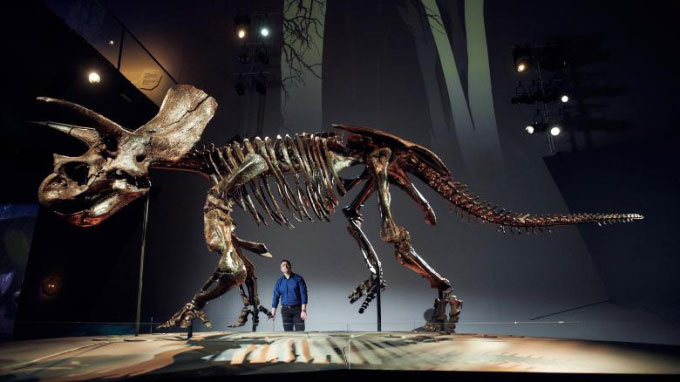The most complete dinosaur fossil at the Australian museum
The 67-million-year-old triceratops specimen from Montana astounds researchers with 266 bone fragments preserved to date.
While walking around a sandstone ridge on private land in the northwestern state of Montana in 2014, paleontologist Craig Pfister stumbled across fossilized pelvic and femur fragments glittering beneath Sunset in a large sinkhole formed from previous rains.

Horridus triceratops fossil.
"I suspected it was something special, but it took some time to dig into the age and quality of the specimen," Pfister said.
The fossil was named Horridus by its new owner, Museums Victoria, Australia's largest museum organization. This nickname comes from the full scientific name Triceratops horridus of a giant three-horned dinosaur that lived 67 million years ago.
Pfister is the founder of Great Plains Paleontology, a Wisconsin-based fossil search and excavation company. During his nearly 30-year career, he has discovered many specimens of tyrannosaurs and other rare species, but Horridus remains the most impressive discovery.
After finding the fossil, Pfister and some colleagues took more than a year to excavate the specimen. That is understandable because Horridus has 266 bones left over. It is nearly 85% complete, 2.5 m high, 7 m long and weighs 1,000 kg. The skull is 98% complete.

Horridus' skeleton is nearly 85% complete.
According to Erich Fitzgerald, senior curator of vertebrate paleontology at Museums Victoria, it is the most complete dinosaur skeleton at any museum in Australia and one of the best preserved triceratops. Best in the world.
Researchers don't fully understand how the herbivorous dinosaur was so perfectly preserved, but Fitzgerald believes it must have been buried shortly after death.
"I suspect that the creature's dead body washed up in a river, then sank rapidly to the bottom and was covered with sand and mud. It could also have died in the water," Fitzgerald explained.
Horridus is part of the Melbourne museum collection of Museums Victoria and it is on public display at this month's Triceratops exhibition.
- Discover the most complete dinosaur fossil
- Found blood cells in dinosaur fossil foundations of 75 million years
- 9-year-old boy found fossil dinosaur eggs 66 million years
- Admire the dinosaur museum in China
- Shocking discovery of dinosaurs drive and
- Intact fossil dinosaur tail discovered
- The world's largest dinosaur footprint has been identified
- Dinosaur park is only in imagination
- Detecting the nocturnal egg nest of the dinosaur fetus
- The largest dinosaur mecca in the world
- The strange stone was identified as a dinosaur brain fossil
- Repeatedly discovered dinosaur fossils in Canada
 Discovered an ancient centipede fossil 99 million years old
Discovered an ancient centipede fossil 99 million years old Discovered bat-like dinosaurs in China
Discovered bat-like dinosaurs in China Discovered a 200-year-old bronze cannon of the coast
Discovered a 200-year-old bronze cannon of the coast Discover 305 million-year-old spider fossils
Discover 305 million-year-old spider fossils